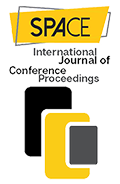The Industrial Heritage: Notion of Atmosphere and Temporality in the Daily Urban Living Praxis
DOI:
https://doi.org/10.51596/sijocp.v3i1.18Keywords:
re-functioning, industrial heritage, atmosphere, temporality, Santral Istanbul, AGUAbstract
Recreating the space means creating a new ‘atmosphere’ there. The atmosphere surrounds the space like the atmosphere layer surrounding the earth. The spaces where the atmosphere of the space can be examined effectively are the spaces that are re-functioned. There are two important and distinct variables that determine the atmosphere formation in re-functional spaces: (1) Time and (2) memory.
In the re-functioning space, the past, present, and future come together and constantly transform each other. This feature emphasises the temporality of these spaces. This approach does not romanticise the space. It focuses on the new space and the atmosphere that changes, transforms, and is fluent in time. This study aims to examine the new spirit and atmosphere of the transformed space rather than telling the transformation story of the old space.
Bilgi University Campus (Santral Istanbul) in Istanbul and Abdullah Gul University Campus in Kayseri, which were re-functionalized and transformed, were determined as similar examples. These two campuses were observed and compared within the scope of criteria determined by grounded theory methodology.
The criteria by which the campuses that have been transformed by re-functioning are evaluated were created by compiling the criteria of architects and philosophers working on the experience of space. These criteria are classified as (1) senses and (2) sensations of space.
After the observations, the criteria for the sensations and senses of space were expanded, were added new criteria and redefined. The place has preserved the spirit of time-memory with elements from the past and created a new, holistic, and original atmosphere with its socially active education campus function. In this respect, the campuses have become re-functionalised industrial heritages that embody the spirit of the time and offer a new atmosphere experience beyond being purely educational campuses.
References
Adam, B. (1990), Time and Social Theory, Polity Press, Cambridge.
Ahunbay, Z. (2011), Urban Architecture in Istanbul, Istanbul Bilgi University Publications
Augustine, S. (1961), Saint Augustine Confessions, translated by Pine Coffin, Penguin Books, England.
Bergson, H. (2017), The Direct Data of Consciousness, Dergah Publications.
Bohme, G. In Engels-Schwarzpaul, A.-C., & Bohme, G. (2017), Atmospheric Architectures: The aesthetics of Felt Spaces, Bloomsbury Academic
Burden, E. (2004), Illustrated Dictionary of Architectural Preservation: Restoration, Renovation, Rehabilitation, Reuse, New York: McGraw-Hill Press.
Cagatay, H. (2019), An Architectural History Index: For İnci Aslanoglu, Kayseri Sumerbank Cloth Factory, written by Burak Asiliskender & Nilufer Baturayoglu Yoney
Deleuze, G. (2001), Difference and Repetition, Continuum
Ekinci, O. (2001), Preservation of Industrial Heritage, Istanbul Magazine, 39, Istanbul.
Giedion, S. (1967), Space, Time, and Architecture, The Growth of a New Tradition, Harvard University Press, Mass.
Hubsch, H. (1992), The Differing Views of Architectural Style in Relation to the Present Time (1847). In What Style Should We Build? USA: The Getty Center.
Kreps, D. (2015), Bergson, Complexity and creative emergence, New York: Palgrave Macmillan.
Lefebvre, H. (1991), The Production of Space, London: Blackwell.
Mostafavi, M. & Leatherbarrow, D. (2005), Architecture Over Time: On the Life and Aging of Buildings, Otuken, Istanbul
Norberg-Schulz, C. (1971), Existence, Space and Architecture, Praeger Publishers.
Okandan, G. D. (2016), A Journey from Modern to Postmodern in the History of Business: Continuity and Change from Silahtaraga Power Plant to Santralistanbul, Journal of Istanbul University Faculty of Business Administration, 45: 40-48. ISSN 1303-1732.
Pallasmaa, J. (2011), Eyes of the Skin - Architecture and the Senses, translated by A. U. Kilic, Yem Yayin, İstanbul.
Rassmussen, S.E. (2000), Experiencing Architecture, MIT Press, USA.
Ricoeur, P. (2012), Memory, History, Forgetting, translated by M. Emin Ozcan, Istanbul: Metis Yayinlari.
Rodowick, D.N. (1997), Gilles Deleuze’s Time Machine, Duke University Press; 122- 38.
Semper, G. (2015), The Four Elements of Architecture and Two Conferences, Istanbul: Janus, (1851).
Ural, S. (2005), Nested Tenses, Time-Space, edited by A. Senturer, S. Ural, O. Berber, F. U. Sonmez, YEM Publications, Istanbul; 16-33, 248.
Sahin, R. (2019), Why Didn't the Industrial Revolution Start in the Ottoman Empire? Business Economics and Management Research Journal, 2 (1), 1-16.
Zumthor, P. (2006), Atmospheres: Architectural Environments, Surrounding Objects, Basel: Birkhauser.
Wolfflin, H. (1952), Classic art: an introduction to the Italian Renaissance, P. Murray & L. Murray, Trans., London: Phaidon.
https://www.santralistanbul.org/tr/hakkinda/ (Last Access: 17.11.2022)
https://earth.google.com/web/ (Last Access: 17.11.2022)
https://ticcih.org/about/about-ticcih/dublin-principles/ (Last Access: 17.11.2022)
Published
How to Cite
Issue
Section
Categories
License
Copyright (c) 2023 Esra Ozdevecioglu, Sedef Ozcelik

This work is licensed under a Creative Commons Attribution 4.0 International License.













